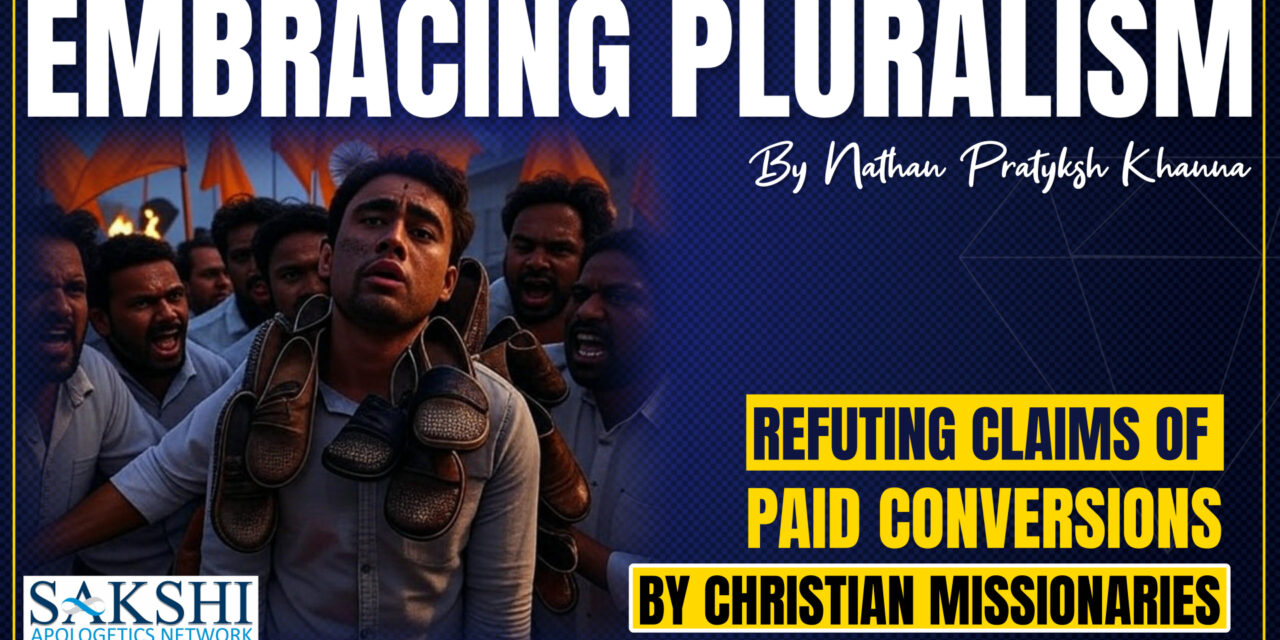The claim that Christian missionaries in India use financial incentives to convert people in India is a persistent narrative often used to justify restrictive laws and communal tensions. This article critically evaluates the evidence for such allegations, drawing on scholarly research, legal records, and personal testimonies to demonstrate their lack of substantiation. It examines the historical and socio-economic context of missionary work, the persecution of Christians fueled by these claims, and the voluntary nature of conversions, supported by quotes from notable Hindu converts to Christianity. Additionally, it addresses the modest lives of Indian pastors, the aggressive conversion tactics employed by some Hindu organizations, and the role of propaganda machines in amplifying divisive narratives. The study argues that the “paid conversion” narrative is a politically motivated distortion that undermines India’s pluralistic ethos and constitutional guarantees of religious freedom.
Allegations that Christian missionaries in India pay Hindus to convert have gained traction, particularly among Hindu nationalist groups, contributing to anti-conversion laws and violence against Christians. These claims portray missionaries as predatory, exploiting vulnerable populations with financial allurements. This article diplomatically examines the evidential basis for these accusations, their socio-political implications, and the resulting persecution of Christian communities. It incorporates scholarly sources, legal outcomes, and testimonies from prominent Hindu converts to highlight the voluntary nature of conversions. Furthermore, it explores the humble lives of Indian pastors, conversion efforts by Hindu organizations, and the role of aggressive propaganda in perpetuating the “paid conversion” myth. The analysis concludes that these allegations lack credible support and threaten India’s religious harmony.
Historical Context of Christian Missionary Work in India
Christianity arrived in India in the 1st century CE with Saint Thomas, establishing communities in Kerala that coexisted with Hindu traditions. Modern missionary activities, from the 18th century, were influenced by European colonial powers, including the Portuguese and British. Missionaries like Hermann Gundert, who compiled a Malayalam dictionary, and Johann Phillip Fabricius, who translated the Bible into Tamil, contributed to education and linguistic development. British policies post-1813 permitted voluntary conversions, emphasizing charity over coercion, unlike the Portuguese Inquisition in Goa.
Missionaries established schools, hospitals, and orphanages, serving marginalized groups like Dalits and tribal communities. These efforts aligned with Christian principles of service, as in Matthew 25:40: “Whatever you did for one of the least of these brothers and sisters of mine, you did for me.” Despite centuries of missionary presence, Christians remain only 2.3% of India’s population, per the 2011 Census, suggesting limited proselytization success. This context challenges claims that missionaries use financial power to “buy” converts.
The “Paid Conversion” Narrative: Origins and Evidence
Allegations of paid conversions often rely on unverified media reports. A 2021 *The Commune* article claimed the International Mission Board (IMB) allocated $175 billion for conversions, an implausible figure lacking corroboration from financial audits or government records. Similarly, *OpIndia* alleged in 2021 that missionaries converted 100,000 people during the COVID-19 pandemic, citing a single unverified interview.
Pew Research Center’s 2021 report, *Religion in India: Tolerance and Segregation*, found that only 0.4% of Indian adults are Hindu converts to Christianity, indicating rare conversions. Legal cases alleging paid conversions frequently fail. In 2024, a Uttar Pradesh court cleared two Christian men of conversion charges, calling them “baseless, unfounded, and fabricated” (*Christian Solidarity International*, 2024). Of 79 cases against pastors from 2020 to 2023, none have been proven, underscoring the speculative nature of these claims.
Socio-Economic Context and Missionary Charity
The “paid conversion” narrative ignores the socio-economic realities of India’s marginalized communities. Dalits and tribal groups, facing caste-based discrimination, often convert voluntarily to escape oppression. Missionaries provide education, healthcare, and vocational training, which critics mischaracterize as “allurement.” These efforts reflect Christian theology, as in James 2:17: “Faith without action is dead.”
A 2012 government report, cited by *Medium* (2024), recorded Rs. 3105.73 crore in foreign funding to Christian NGOs, linked to welfare, not conversions. The Foreign Contribution Regulation Act (FCRA) enforces strict oversight, requiring NGOs to register and submit returns, minimizing illicit transactions. The lack of financial records or credible testimonies weakens claims of monetary inducement.
The Modest Lives of Indian Pastors
Indian pastors, particularly in rural areas, often live in poverty, yet their dedication to sharing the Christian message remains steadfast. Many serve small congregations, surviving on meager stipends or community support, with limited access to healthcare or education for their families. A 2023 *The Christian Post* report highlighted pastors in Uttar Pradesh earning less than $100 monthly, often facing harassment for their work. Despite these challenges, they preach the Gospel, driven by faith and a commitment to serve, as exemplified in Mark 16:15: “Go into all the world and preach the gospel to all creation.” Their sacrifices contrast sharply with the narrative of missionaries as wealthy manipulators, underscoring the altruistic nature of their mission.
Persecution of Christian Communities
The “paid conversion” narrative has fueled significant persecution of Christians, particularly in states with strong Hindu nationalist influence. Misinformation propagated by some Hindutva advocates, while rooted in cultural preservation concerns, has led to hostility. The United States Commission on International Religious Freedom (USCIRF) reported in 2024 that Christians faced church vandalism, pastor arrests, and mob violence, often tied to conversion accusations. In 2023, *Christian Solidarity International* documented 1,198 anti-Christian incidents, many linked to this narrative.
Anti-conversion laws in 13 states, which broadly define “allurement” to include charity, have been criticized by the United Nations for violating Article 25 of India’s Constitution. These laws disproportionately target Christians while exempting “re-conversions” to Hinduism (ghar wapsi). A 2023 Madhya Pradesh incident saw a Christian school attacked over unproven conversion allegations (*The Print*, 2023). Such baseless claims endanger Christians and undermine India’s pluralistic ethos.
Aggressive Hindu Narrative Propaganda Machines
The “paid conversion” narrative is amplified by aggressive propaganda machines like Agniveer and the NoConversion Facebook page, which promote anti-Christian rhetoric. Agniveer, a Hindu nationalist platform, frequently posts content alleging missionary coercion, such as a few posts claiming pastors converting people (*Agniveer*, 2025). NoConversion similarly shares memes and videos depicting Christians as threats, often without evidence. Three other groups—Hindu Janajagruti Samiti (HJS), Bajrang Dal, and Hindu American Foundation (HAF)—employ comparable tactics. HJS uses Facebook to demonize minorities, with 46 pages and 75 groups promoting hostile narratives (*DFRLab*, 2021). Bajrang Dal, a militaristic youth wing, incites violence through “No Conversion” campaigns, including anti-Christian memes (*Equality Labs*, 2019). HAF, active in the US, pushes Hindutva narratives, opposing caste-equity laws while framing criticism as “Hinduphobia” (*Project MUSE*, 2023). These groups fuel communal tensions, often mirroring the proselytizing zeal they criticize.
Conversion Efforts by Hindu Organizations
Some Hindu organizations employ aggressive tactics to convert Christians, both in India and abroad, often mirroring or surpassing the methods they criticize in missionaries. The Rashtriya Swayamsevak Sangh (RSS), Vishwa Hindu Parishad (VHP), and the International Society for Krishna Consciousness (ISKCON) are prominent examples. In India, RSS and VHP-led ghar wapsi campaigns pressure Christians, particularly Dalits, to “reconvert” to Hinduism, using incentives like food or threats of social exclusion. A 2020 *Providence Magazine* article reported 2,000 such “re-conversions” in Uttar Pradesh, often under duress. Abroad, ISKCON targets Christians in Western countries through cultural festivals and vegetarianism to promote Krishna devotion. A 2022 *The Guardian* report noted ISKCON’s growth in the UK, attracting former Christians with free meals and spiritual workshops. While ISKCON’s approach is less coercive, the RSS and VHP’s tactics highlight a double standard in criticizing Christian missionary work.
Perspectives from Hindu Converts to Christianity
Testimonies from prominent Hindu converts to Christianity underscore the voluntary nature of conversions, countering financial inducement claims. Their reasons reflect spiritual or social motivations.
– Pandita Ramabai (1858–1922), a scholar and reformer, converted after studying Christian teachings. She stated, “I found in Christ the answer to my heart’s longing for truth and justice, which I could not find elsewhere” (*My Testimony*, 1907). Her conversion led to founding schools for widows.
– Narayan Vaman Tilak (1861–1919), a Brahmin poet, embraced Christianity after engaging with its scriptures. He wrote, “In Jesus, I saw the embodiment of love and sacrifice, which transcended the rituals of my birth” (*Poems of a Christian Bhakta*, 1920). Tilak’s hymns blended Indian culture with Christian faith.
– B.R. Ambedkar (1891–1956), though ultimately Buddhist, considered Christianity to escape caste oppression. He noted, “Christianity offers dignity to the oppressed, a promise of equality that caste denies” (*The Annihilation of Caste*, 1936). His exploration highlights social motivations for conversion.
These accounts demonstrate conversions driven by conviction, not money, weakening the “paid conversion” narrative.
Political and Ideological Motivations
The “paid conversion” narrative aligns with Hindu nationalist ideologies, particularly Hindutva, which envisions India as a Hindu nation. Organizations like the RSS and VHP frame missionaries as threats to cultural unity, alleging foreign-funded conversions. While these groups seek to protect heritage, their reliance on unverified claims fosters division. The narrative has fueled anti-conversion laws and ghar wapsi campaigns, often exempt from legal scrutiny.
The Modi government’s FCRA amendments (2016–2023) tightened foreign funding controls, making illicit transactions implausible. The Christian population’s stagnation at 2.3% since 1951 contradicts claims of a financially driven conversion campaign. The narrative thus serves political ends, diverting attention from caste discrimination, a key driver of voluntary conversions.
Counterarguments and Rebuttals
Proponents of the “paid conversion” narrative cite isolated incidents of aid post-conversion, arguing missionaries exploit economic vulnerabilities. However, these anecdotes lack generalizability, and conversions often stem from social oppression, as Ambedkar noted. Another claim is that foreign funding implies conversion agendas, but the 2012 government report confirms funds support welfare. The low conversion rate reported by Pew Research Center further undermines inducement claims.
Conclusion
The allegation that Christian missionaries pay Hindus to convert in India is unsupported by evidence and misrepresents missionary work. Scholarly data, legal outcomes, and testimonies from figures like Pandita Ramabai, Narayan Tilak, and B.R. Ambedkar show conversions are rare and voluntary, driven by spiritual or social factors. The narrative, amplified by propaganda machines like Agniveer and NoConversion, has fueled Christian persecution and overlooks the humble lives of pastors. Hindu organizations like the RSS, VHP, and ISKCON employ similar or aggressive conversion tactics, revealing a double standard. While respecting cultural concerns, evidence-based discourse is essential to uphold India’s pluralistic ethos and constitutional religious freedom.
We invite each of you, regardless of your background or beliefs, to open your hearts and discover the transformative love of Jesus Christ. He offers a path to eternal life, a promise of peace, and a purpose that transcends the struggles of this world. By embracing His teachings, you can find hope, forgiveness, and a deep connection with the divine that brings true fulfillment. Take a moment to reflect on His invitation to you personally, and consider the eternal joy that awaits. As John 3:16 reminds us, “For God so loved the world that He gave His one and only Son, that whoever believes in Him shall not perish but have eternal life.”
References:
– Pew Research Center. (2021). *Religion in India: Tolerance and Segregation*.
– Christian Solidarity International. (2024). *Christians Cleared of Forcibly Converting Hindus in Landmark Case*.
– United States Commission on International Religious Freedom. (2024). *Annual Report on India*.
– The Christian Post. (2023). *The Myth of Charities and Paid Conversion in India*.
– Medium. (2024). *Christian Missionaries on Conversion Spree in India*.
– The Print. (2023). *Christian School Attacked in Madhya Pradesh Over Conversion Allegations*.
– Providence Magazine. (2024). *Forced Conversions of Christians in India*.
– The Guardian. (2022). *ISKCON’s Growth in the UK*.
– Ambedkar, B.R. (1936). *The Annihilation of Caste*.
– Ramabai, P. (1907). *My Testimony*.
– Tilak, N.V. (1920). *Poems of a Christian Bhakta*.
– DFRLab. (2021). *Violent Religious-Nationalist Cult Targets India’s Minorities on Facebook*.[](https://medium.com/dfrlab/violent-religious-nationalist-cult-targets-indias-minorities-on-facebook-b6be61bd5084)
– Equality Labs. (2019). *Facebook India: Hate Speech and Disinformation*.(https://www.equalitylabs.org/facebookindiareport)
– Project MUSE. (2023). *How Facebook’s Recommendation Model Reinforces Hindu Nationalism*.(https://muse.jhu.edu/article/916427)
– Agniveer. (2025). *Missionary Pastors Harass & Abuse Hindu Women in Punjab*.(https://x.com/agniveer/)




